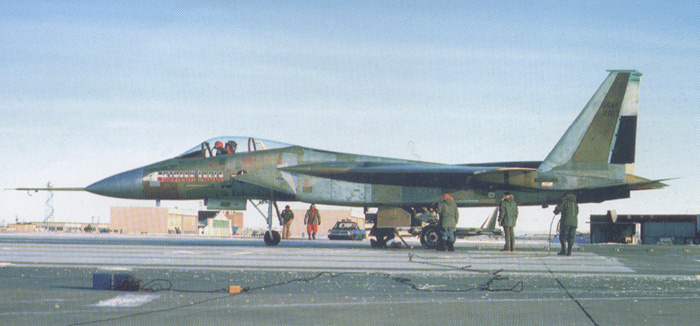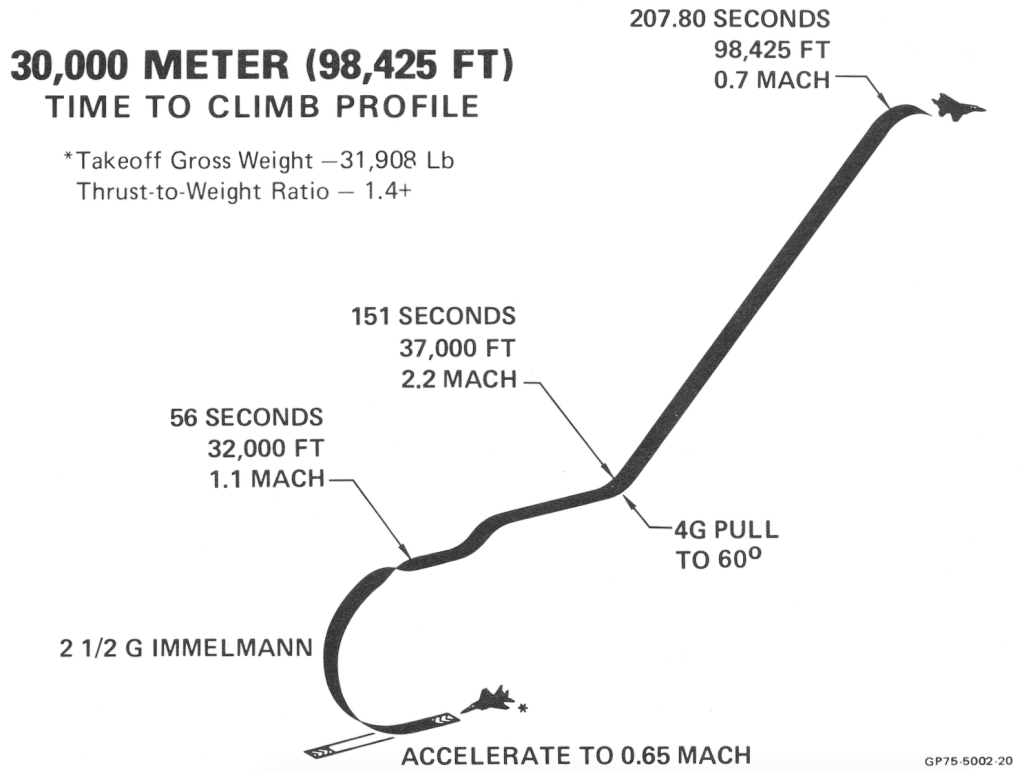Both the United States Air Force and McDonnell Douglas understood that a fighter’s speed might make headlines. In late 1974, they came together to plan an event to show the world the new F-15 fighter and the US taxpayer what they were receiving for their money.
As a result, at the cost of more than $2 million, a show was organized in which a stripped and lightened early F-15 broke a number of time-to-height records. Five of these records were set by the F-4 Phantom II, the F-15’s predecessor, beginning in 1962, while the Soviets held the higher-altitude ones with their MiG-25 Foxbat. Three US Air Force pilots were chosen to take part in this endeavor, and they would break all eight records over the course of 17 days, from January 16 to February 1, 1975, over Grand Forks Air Force Base in North Dakota.

What was the F-15 Streak Eagle? It was the 19th preproduction F-15, and it had been stripped of all non-essential materials and equipment. The radar, the Vulcan, ammo ‘bin’ and feed chutes, flap and speed-brake actuators, radios, one hydraulic system, certain cockpit displays, and a generator were all removed. A few items were added, such as a pressure suit for the pilot on some tries, a pitot boom to provide additional information to the pilot, and instrumentation to measure the aircraft’s speed and acceleration.
With every attempt starting from a standing start, the arrestor hook was swapped with a hold-down hook that would be released once the timer was started. In addition, the aircraft’s whole surface was left unpainted to conserve weight. The improvements made the F-15 Streak Eagle 1,800lb (817kg) lighter than a standard F-15A, and to guarantee the greatest performance, only a sufficient quantity of fuel for the attempt was filled the Eagle’s tanks. The F-15 Streak Eagle was estimated to have a thrust-to-weight ratio of about 1.5:1.

On January 16, five F-4 records were broken in a single day. The first record to go was the ‘Time to 3,000m (9843ft)’, which Major Roger Smith owned by 20%. The aircraft was brought to full throttle using the hold-back system, and when released, the F-15 Streak Eagle took off after only a 400-metre take-off roll. The acceleration was so rapid that the pilot had to act quickly to have the undercarriage tucked down before the related gear and doors exceeded its ‘never-exceed speed’ as the aircraft rose almost vertically in a 5g climb. Some attempts were in fact stopped due to this issue.
The next three records were broken in a single flight, with timings recorded at the appropriate altitudes. In the ‘Time to 6,000m (19,685ft)’ effort, Major Willard Macfarlane topped the F-4’s time by 19% (48.79s vs 39.33s). In the ‘Time to 9,000m (29,528ft)’, the F-15 Streak Eagle surpassed the F-4’s record of 61.68s by 21%, reaching the needed altitude in 48.86s. The Eagle’s best time for the 12,000m (39,370ft) effort was 77.14s, 23% faster than the F-4’s time of 59.38s.

The final of the three flights that day saw Major Dave Peterson break the former ‘Time to 15,000m (49,212ft)’ record by 33%: the F-4 could reach the height in 114.50 seconds but was blasted by the Eagle’s 77.02 seconds. Pilots would wear complete pressure suits throughout this attempt and all subsequent flights. As Peterson lifted to around 50 feet above the runway at Mach 0.65, he yanked hard on the F-15’s control column and reached the target altitude about 10 seconds faster than the Saturn V moon rocket!
It was time to break the Soviet MiG-25 Foxbat’s 1973 record. On January 19, Smith broke the ‘Time to 20,000m (65,617ft)’ record by over 28%, with the MiG-25 clocking 169.80 seconds and the Eagle 122.94. The F-15 Streak Eagle would begin ‘on the deck’ at roughly Mach 0.65 before pulling up at just 2.5g into an Immelmann over the top at 32,000ft before accelerating in the opposite direction to take-off, then pulling a 4g, 55° ascent supersonic until it reached the required height. The same technique would be utilized for the higher altitude record flights.

On January 26, Peterson broke the Soviet aircraft’s 25,000m (82,021 ft) record, clocking 192.60s to the Eagle’s 161.02. Smith was back for the 30,000m (98,425ft) record on February 1, where the F-15 Streak Eagle would have a 15% winning lead due to their 207.80s ‘to-height’ time over the MiG’s 243.86s.
These records would serve as a huge PR coup for both the USAF and McDonnell Douglas. The records were so successful that they didn’t fall until the 1980s, when a similarly stripped Sukhoi SU-27/T-10 (also known as the P-42) broke them between 1986 and 1988, apparently gloating an almost 2:1 thrust-to-weight ratio!
In December 1980, the F-15 Streak Eagle was delivered to the National Museum of the United States Air Force at Wright-Patterson Air Force Base in Ohio.









